Watched some videos on the Ellen White tree planting method, and adapted it a bit. The trees I'm planting are 3yo seedling apples that will be grafted over to some of my existing varieties that perform well.
Started by digging a 3' x 3' hole, 30 inches deep. You can see from the pic I've got about 8 inches of topsoil, with sand below that.
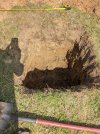
These are most of the rocks from the hole.
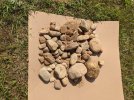
In the bottom I put a bunch of organic matter, in this case some red spike amaranth, a cousin of pigweed. I use the main trunk, the branches, leaves, and flowers. This works as green manure.

After that I add several inches of horse manure.
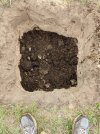
Then I put in all of the rocks I had set aside from the hole, except for a couple of the largest ones. Supposedly there is a study showing that this rock layer helps with the electrical conductivity in the hole, which will encourage the tree roots to go deeper.
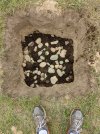
Then another layer of several inches of horse manure. On top of that I put the large rocks that came from the hole. Supposedly, the tree roots will grab these rocks, using them as an anchor to hold itself firmly in place. The empty coffee can is meant to provide air to keep things aerobic.
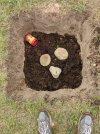
Then a few inches of well composted manure and whatever soil amendments I have. I added coffee grounds, pelleted lime, Redmond soil conditioner, and some chunks out of a protein tub used as a cattle supplement.
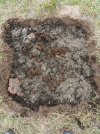
And finally the tree itself, with more compost to fill up the hole.
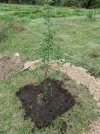
I sprayed water after every layer of manure or compost to make sure everything was saturated. There was probably 5 or 6 dozen earthworms in the manure and compost. To finish everything off I used a bucket with a couple of small holes at the bottom to add another 5 gallons of water. Into that I added a cup of my own liquid fertilizer.

We'll see how well this works. Just have top them off with some mulch and a cage. Took several hours to get 4 trees planted.
Started by digging a 3' x 3' hole, 30 inches deep. You can see from the pic I've got about 8 inches of topsoil, with sand below that.

These are most of the rocks from the hole.

In the bottom I put a bunch of organic matter, in this case some red spike amaranth, a cousin of pigweed. I use the main trunk, the branches, leaves, and flowers. This works as green manure.

After that I add several inches of horse manure.

Then I put in all of the rocks I had set aside from the hole, except for a couple of the largest ones. Supposedly there is a study showing that this rock layer helps with the electrical conductivity in the hole, which will encourage the tree roots to go deeper.

Then another layer of several inches of horse manure. On top of that I put the large rocks that came from the hole. Supposedly, the tree roots will grab these rocks, using them as an anchor to hold itself firmly in place. The empty coffee can is meant to provide air to keep things aerobic.

Then a few inches of well composted manure and whatever soil amendments I have. I added coffee grounds, pelleted lime, Redmond soil conditioner, and some chunks out of a protein tub used as a cattle supplement.

And finally the tree itself, with more compost to fill up the hole.

I sprayed water after every layer of manure or compost to make sure everything was saturated. There was probably 5 or 6 dozen earthworms in the manure and compost. To finish everything off I used a bucket with a couple of small holes at the bottom to add another 5 gallons of water. Into that I added a cup of my own liquid fertilizer.

We'll see how well this works. Just have top them off with some mulch and a cage. Took several hours to get 4 trees planted.